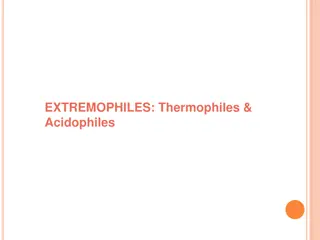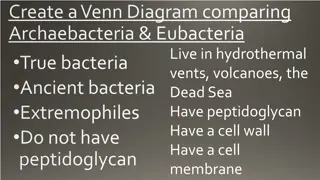
Extremophiles and Their Survival Mechanisms
Learn about extremophiles such as alkaliphiles, xerophiles, and halophiles, and how they thrive in extreme conditions like high pH, low water availability, and high salt concentrations. Discover the unique cellular mechanisms these microorganisms employ to survive in their harsh environments.
Download Presentation

Please find below an Image/Link to download the presentation.
The content on the website is provided AS IS for your information and personal use only. It may not be sold, licensed, or shared on other websites without obtaining consent from the author. If you encounter any issues during the download, it is possible that the publisher has removed the file from their server.
You are allowed to download the files provided on this website for personal or commercial use, subject to the condition that they are used lawfully. All files are the property of their respective owners.
The content on the website is provided AS IS for your information and personal use only. It may not be sold, licensed, or shared on other websites without obtaining consent from the author.
E N D
Presentation Transcript
ALKALIPHILES These are extremophilic microorganisms which thrives in roughly alkaline environments (8-11), and have an optimum of pH around 10. Organisms which needs high pH to survive are called as obligate alkaliphiles. There are facultative alkaliphiles and haloalkaliphiles (needs salty environment as well). Most of the alkaliphiles possess a bacillus morphology. Eg: Bacillus halodurans C125, Bacillus firmus OF4
Two methods for surviving 1. The cell will be having a unique cellular machinery that works best in alkaline range of pH. 2. The cell will have to acidify the cytosol to nullify the effect of the high pH outside the cell.
Experimental studies revealed that the cytosolic enzymes of alkaliphiles functions best in a neutral pH range (7.5-8.5). This shows that for surviving in highly alkaline pH, the cell must have some pH regulatory mechanism to protect the plasma membrane. The mechanism is that the cell wall contains acidic polymers composed galacturonic acid, gluconic acid, glutamic acid, aspartic acid, and phosphoric acid. This protects the PM by preventing the entry of hydroxide ions and allowing the entry of sodium (Na+) and hydronium ions(H+) of residues such as
XEROPHILES A xerophile (from Greek x ros , meaning "dry", and philos, meaning an extremophilic organism that can grow and reproduce in conditions with a low availability of water. Water activity (aw) is a measure of the amount of water within a substrate an organism can use to support sexual growth. Xerophiles are often said to be "xerotolerant", meaning tolerant of dry conditions. environments with water activity below 0.8. Endoliths and halophiles are often xerotolerant. Eg: many molds and yeast, Trichosporonoides nigrescens "loving"), is They can survive in
HALOPHILES This group comprises microorganisms that can thrive in high salty environments such as The Great Salt Lake and Dead Sea. Most of the halophiles belong to the DomainArchae. Eg: Salinibacter ruber There are eukaryotic halophiles such as Dunaliella salina (algae) and Wallemia icthyophaga (fungus). Extreme halophiles/obligate halophiles-adapted to survive high salt concentrations Organisms from Dead Sea often requires nearly 33% salt (sea water has only 3%), and the inoculating loop must be dipped in a saturated salt solution to isolate them. Microorganisms live in such high salinity are termed as extreme halophiles
Mechanism Mainly employ two mechanism to prevent desiccation through osmosis. Both strategies work by increasing the osmotic concentration of the cell. 1.In first method (followed my most halophiles including bacteria, archae etc) organic compounds are accumulated in the cytoplasm. They are known as osmoprotectants or compatible solutes. It include sugars, aminoacids, polyols, betaines etc. These compounds can be synthesised or accumulated from the environment. Eg: Ectothiorhodospira halochloris
2. The second is the selective influx of potassium ions (K+) into the cytoplasm. This adaptation is restricted to moderately halophilic organisms. The entire intracellular machinery (enzymes, structural proteins etc) is highly adapted to withstand the high saline environment. Eg: Bacteria comes under the Family Halobacteriaceae The 16S rRNA studies opens a broad range of information on the field of evolution.
ENDOLITHS Endolith is an organism (archae, bacterium, fungus, lichen or algae) that lives in nutritionally poor environments such as inside a rock or something. Particularly interesting in the area of astrobiology (exobiology). These organisms opens a clue for life beyond earth. There are chances of having life on endolithic environments such as mars and other planets.
Characteristics Endoliths have been found in rocks down to the depth of 3 km. It is not known that whether this is the limit since digging to the deep is highly expensive. The major threats to live in such depth is the high temperature. Recently discovered strains can reproduce at 1210C. All the discovered organisms are autotrophs. Some utilize gas or dissolved nutrients from water moving through fractured rocks Others may incorporate inorganic compounds found in their rock substrate (possibly by excreting acids to dissolve the rock).
Endoliths can be classified into Chasmoendoliths Colonizes fissures and cracks in the rock (chasmo- cleft) Cryptoendolith Colonizes structural cavities within porous rocks, including spaces produced and vacated by euendoliths (crypto = hidden) Euendolith Penetrates actively into the interior of rocks forming tunnels that conform with the shape of its body(eu = good, true).
Endolithic life form found inside an Antarctic rock http://en.wikipedia.org/wiki/File:Cryptoendolith.jpghttp:// en.wikipedia.org/wiki/File:Cryptoendolith.jpg
Obligate Anaerobes Microorganisms which grow strictly in the absence ofmolecular oxygen are called as obligate anaerobes. For these, oxygen is a toxin For energy generation, they must employ fermentation oranaerobic respiration pathways. The toxic forms of oxygen are Singlet Oxygen(O2),Superoxide radicals (O -), peroxide anion (O 2-), and hydroxyl radical (OH). Some obligate anaerobes are Clostridium spp, Methanococcusand Methanopyrus Microorganisms which can live both in the presence and absenceof oxygen are known as FacultativeAnaerobes. They can utilize oxygen if available or, continue their growth by fermentation and anaerobic respiration. Eg: Bacillus anthracis, Escherichia coli 2 2
To routinely grow and maintain in pure cultures, reducing media which stored in ordinary, tightly packed tubes is been used.( media containing thioglycollate or cystein) For culturing in petriplates, sealed boxes and jars in which oxygen removed completely is been used. Sometimes, certain chemicals hydrogen and carbon di oxide will be added and the so formed hydrogen will be incorporated with the oxygen present in the container to yield water This water can be utilized by the microorganisms. The most advanced system is that the media used for culture will be containing an enzyme- oxyrase which will bind with oxygen and eliminate as water. No addition of extra chemicals or hydrogen is needed. which can produce
Radiation Although most living things are sensitive to radiation, there are some microorganisms which can resist high levels of radiation. Deinococcus radiodurans is the radioresistant organism discovered so far which is a eubacteria. Their ability to withstand radiation is more than that of endospores. They can survive exposure to radiation doses as high as 15,000 Grays. This much radiation is 1500 times the dosage that would kill a human. The mechanism for this extraordinary resistance lies in a unique arrangement of its DNA that facilitates a rapid repair of radiation damage. It is similarly resistant to many mutagenic chemicals.
Barophiles Microorganisms that can survive under immense hydrostatic pressure. Generally found in ocean floors where pressure exceeds 300 atm (38 MPa). Some have been found at the bottom of the Pacific Ocean (Mariana Trench-10500 m) where pressure often exceeds 117 MPa. These organisms cannot grow in pressure below 400-500 atm True obligate barophiles also comprises bacteria which present in the gut of holothurians and amphipods (crustaceans). Eg: Photobacterium, Shewanella, Colwellia Some thermophilc archae such as Pyrococcus spp., Methanococcus jannaschii are barophiles too.
SOME INTERESTING FACTS Halomonas responsible for rusting of RMS Titanic. Pseudomonas putida (super bug) is engineered bacteria which literally eats products. These are very much useful in oil spills. GFAJ-1 is a strain of rod shaped bacteria family Halomonadaceae which is an extremophile, highly resistant to the dangerous poison-Arsenic. There are chances of life forms beyond earth and the field of study is known as astrobiology. titanicae- the bacterium which is a genetically petroleum in the
The study of origin, evolution, distribution, and future of life in the universe and life forms that are extraterrestrial. Astrobiology arises a question whether life exists beyond Earth and if so, how it can be detected by humans. Nucleic acids might not be the only biomolecules which codes for life. Astrobiology of physics, chemistry, astronomy, biology, molecula r biology, ecology, planetary science, geography, and geology to investigate the possibility of life on other worlds and help recognize biosphere that might be different from the biosphere on Earth. makes use
Recent changed possibility of life in the universe, estimates of habitable zones around other stars and the search for extraterrestrial microbial life. The possibility that viruses has been proposed. Efforts to discover life on Mars, either currently or in the past, is an active area of research. Europa has emerged as one of the top locations in advances fundamental in planetary assumptions science about raising the have the might also exist extraterrestrially the habitability hosting extraterrestrial life due to the presence of liquid water (somewhat an ocean). Solar System and in the terms of potential possibility of










